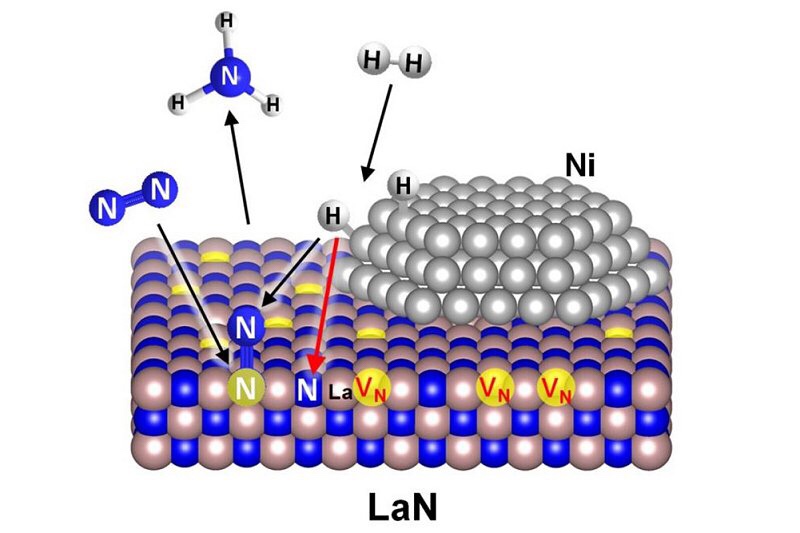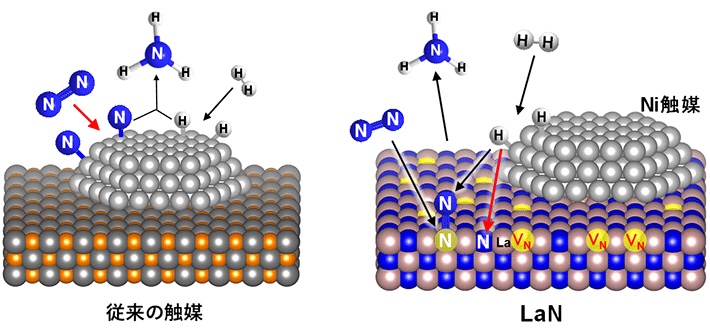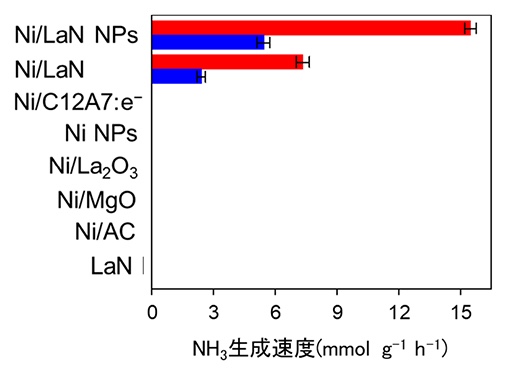

従来の触媒(左)と開発した触媒Ni/LaN(右)上でのアンモニア合成の反応メカニズム。VNはLaN上に形成される窒素空孔であり、赤の矢印が律速段階の反応過程。N2の解離は金属表面ではなく、LaN表面の窒素空孔で起こる。

Niを固定したLaNのアンモニア合成活性と他の触媒との比較(反応温度:400 ℃、圧力:1気圧(青)、9気圧(赤))
東工大:高効率アンモニア合成に成功:Ni・LaN触媒を使用(動画):
TIT: Successful highly efficient ammonia synthesis:Using Ni/LaN catalyst:
东京工业大学:成功的高效氨合成:使用Ni / LaN催化剂
公開日:2020.07.16
要点:
- 単独では活性を示さないニッケル(Ni)と窒化ランタン(LaN)を用いた、高効率アンモニア合成に成功
- ルテニウムなどの貴金属を使わずに、高いアンモニア合成活性を実現
- LaN表面の窒素空孔を反応場として利用する新コンセプトを実証
概要:
東京工業大学 元素戦略研究センター
- 細野栄誉教授、
- 叶天南(Tian-Nan Ye)特任助教、
- 北野准教授
今回のアンモニア合成触媒:
単独では活性を示さないニッケル(Ni)と窒化ランタン(LaN)を組み合わせることで、ルテニウムなどの貴金属触媒に匹敵する優れたアンモニア合成触媒を実現した。
従来のアンモニア合成触媒:
- これまでのアンモニア合成触媒は、
- 高温高圧下での合成では、鉄を使う。
- 温和な条件では、ルテニウムを使う。
いずれの金属も窒素と強く結合するので、金属上で反応が生じていた。
一方、窒素との結合がきわめて弱いニッケルは、窒素分子を活性化できないことからこれまで使用されてこなかった。
今回の研究では:
- 水素分子の活性化をニッケル上で、
- 窒素分子の活性化をLaN上の窒素空孔で、
- それぞれ行うことで、きわめて高いアンモニア合成活性を実現。
窒素空孔という反応場の利用:
単独では活性を示さない金属を用いて優れたアンモニア合成が実現できることを示した。
従来の常識を覆す研究成果である。
本研究の成果:
近年開発された、温和な条件下で高いアンモニア合成活性を示す触媒は、いずれも貴金属であるルテニウムの担持が必要であった。
本研究では、希少で高価なルテニウムを用いない新触媒技術として重要。
アンモニア合成プロセスの新たな可能性に繋がる。
研究成果は英国科学誌「Nature」に7月16日付(日本時間)でオンライン公開された。
東工大ニュース | 東京工業大学
https://www.titech.ac.jp/news/2020/047268.html
Vacancy-enabled N 2 activation for ammonia synthesis on an Ni-loaded catalyst
Article
Published: 15 July 2020
Vacancy-enabled N2 activation for ammonia synthesis on an Ni-loaded catalyst
Tian-Nan Ye, Sang-Won Park, […]Hideo Hosono
Nature volume 583, pages391–395(2020)Cite this article
Abstract
Ammonia (NH3) is pivotal to the fertilizer industry and one of the most commonly produced chemicals1.
The direct use of atmospheric nitrogen (N2)
had been challenging, owing to its large bond energy (945 kilojoules per mole)2,3, until the development of the Haber–Bosch process.
Subsequently, many strategies
have been explored to reduce the activation barrier of the N≡N bond and make the process more efficient.
These include using alkali and alkaline earth metal oxides as promoters to boost the performance of traditional iron- and ruthenium-based catalysts4,5,6 via electron transfer from the promoters to the antibonding bonds of N2 through transition metals7,8.
An electride support further lowers the activation barrier because its low work function and high electron density enhance electron transfer to transition metals9,10.